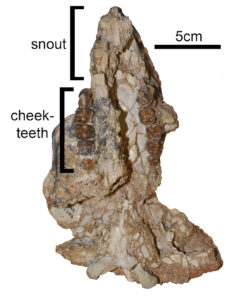A group of Australian and international palaeontologists have identified a giant wombat-like animal so unique they had to create an entirely new family of marsupials.
In a paper published in Scientific Reports, researchers from Griffith University, the University of Salford, the Natural History Museum in London and the University of New South Wales analysed and described the 25-million-year old fossil remains found in central Australia, known as Mukupirna.
The name in Dieri and Malyangapa, the Aboriginal languages spoken where the fossil was found, means “big bones”; an appropriate name for a skeleton and partial skull which belonged to an animal weighing in at about 150 kg.
An analysis of evolutionary relationships shows that Mukupirna is most closely related to wombats, but it has several unique features that reveal it to be the only known member of a new family of marsupials previously unknown to science.
Associate Professor Julien Louys from Griffith University’s Australian Research Centre for Human Evolution described the anatomy of Mukupirna from the remains of its skeleton.

Skull of the giant wombat relative Mukupirna nambensis, looking from below. The front of the skull is towards the top. Total skull length is 19.7 cm.
“The description of this new family fills a crucial missing piece to the ancient bestiary of Australia,” Associate Professor Louys said.
“It joins other weird and extinct marsupials from 25 million years ago, many of which we wouldn’t recognise today.”
UNSW Professor Mike Archer, a co-author on the paper, was part of the original international team of palaeontologists that found the skeleton in 1975 in the clay floor of Lake Pinpa, a remote dry saltlake east of the Flinders Ranges in South Australia.
“The discovery of Mukupirna was in part due to good luck after an unusual change in local conditions exposed the 25 million-year-old fossil deposit on the floor of the dry saltlake,” Professor Archer said.
“When the skeleton was first discovered just below the surface, nobody had any idea what kind of animal it was because it was solidly encased in clay.”
It’s for this reason that lead author Dr Robin Beck says Mukupirna is one of the best-preserved marsupials we know of this age from Australia and tells us a lot about the evolution of wombats, koalas and their relatives.
“It is remarkable for its large size — this was clearly an impressive, powerful beast, at least four times larger than modern wombats”.
“It probably lived in an open forest environment without grasses, but developed teeth that would have allowed it to feed on sedges, roots, and tubers that it could have dug up with its powerful front legs.”
Associate Professor Louys performed a comparative anatomical analyses on Mukupirna with other animals in an effort to understand its biology and place within the marsupial family tree.
“Our analysis showed that Mukupirna was adapted for scratch-digging, but had not yet developed the full limb modifications necessary to regularly burrow and its teeth arrangement was similar to an ancient family of marsupials known as Wynyardiids, early relatives of the wombat.”
The scientists also looked at how body size has evolved in Vombatiforms, the group of animals that includes Mukupirna, wombats, koalas and their fossil relatives, and showed that body weights of 100kg or more evolved at least six times over the past 25 million years.
“Animals like Mukupirna show that the extinct relatives of koalas and wombats were extraordinary giants,” Dr Beck said.
